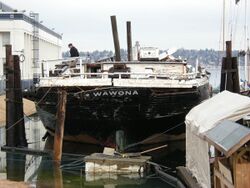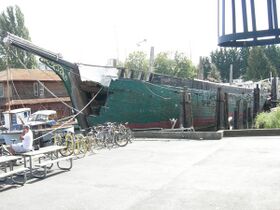Wawona (schooner)
Topic: Engineering
 From HandWiki - Reading time: 4 min
From HandWiki - Reading time: 4 min
 Wawona, 2009
| |
| History | |
|---|---|
| Builder: | Hans Ditlev Bendixsen, near Eureka, California |
| Out of service: | 1948 |
| Fate: | Dismantled, 2009 |
| General characteristics | |
| Class and type: | Fore-and-aft schooner |
| Length: | 165 feet (50 m) |
| Beam: | 35 feet (11 m) |
| Draft: | 12 feet (3.7 m) |
Wawona (schooner) | |
 Wawona, 2007 | |
| Location | Seattle, Washington |
| Coordinates | [ ⚑ ] : 47°37′37″N 122°20′10″W / 47.62694°N 122.33611°W |
| Built | 1897 |
| Architect | Hans Bendixsen |
| NRHP reference # | 70000643[1] |
| Significant dates | |
| Added to NRHP | 1 July 1970 |
| Designated SEATL | 14 March 1977[2] |
Wawona was an American three-masted, fore-and-aft schooner that sailed from 1897 to 1947 as a lumber carrier and fishing vessel based in Puget Sound. She was one of the last survivors of the sailing schooners in the West Coast lumber trade to San Francisco from Washington, Oregon, and Northern California.
She was an iconic ship representing the Pacific Northwest's maritime history. Following her 50-year career at sea, she was a museum ship for over 60 years. Her dismantled wood and steel were reformed into a sculpture in the Museum of History & Industry in 2012 and will be preserved there for the future.[3]
History
Wawona was built near Eureka, California on Humboldt Bay by Hans Ditlev Bendixsen, who was one of the most important West Coast shipbuilders of the late 19th century. The vessel was 165 feet (50 m) long with a 35-foot (11 m) beam. Her masts were 110 feet (34 m) tall.
Lumber
From 1897 to 1913, the schooner carried lumber from Grays Harbor and Puget Sound ports to California . One of her captains, Ralph E. "Matt" Peasley, inspired a series of popular novels.[4][5][6][7]
Fishing
From 1914 until 1947, except during World War II, Wawona sailed to the Bering Sea with a crew of 36 to fish for cod. In 1935, her captain, Charles Foss, died at the wheel during a storm in the Aleutian Islands. Her service ended in 1948.
Museum Ship
After her active career, Wawona began a career as a museum ship at the Seattle Museum of History & Industry (MOHAI). Wawona was berthed at the Museum of History & Industry's pier at South Lake Union Park.[3] The pier features several other historically important ships and is adjacent to the Center for Wooden Boats which provides educational experiences in maritime history.
Wawona was listed on the National Register of Historic Places in 1970. She was also on the Washington State Heritage Register, and was an official city landmark.[8] Her designs are maintained in the Library of Congress.[9]
Restoration and dismantling
In 1964, sixteen years after the vessel's retirement, a group of Seattle residents, headed by Kay Bullitt, formed Northwest Seaport and purchased Wawona as a museum ship. The schooner was made available for public visits during her ongoing restoration.[10][failed verification]
Wawona was towed to a dry dock and dismantled on March 2, 2009. Some of the vessel's features were preserved for the museum.[11]
Wawona was hauled to the Lake Union Drydock on 4 March 2009 and was dismantled. The only remaining West Coast lumber transport sailing ship is C.A. Thayer.[12]
Museum sculpture
Following her demolition, MOHAI commissioned artist John Grade to use the salvaged materials from the ship to create an art piece.
Grade created a massive 65-foot sculpture called Wawona that stands in the center of the Grand Atrium of the MOHAI. The sculpture extends below the floor and above the roof of the Museum. Wood from the ship was also used to create the museum's front desk and the bar at the museum's Compass Cafe.[3]
See also
- Northwest Seaport
- United States lightship Swiftsure (LV-83)
- Arthur Foss
- Historic preservation
- National Register of Historic Places
- List of schooners
Notes
- ↑ "National Register Information System". National Register of Historic Places. National Park Service. January 23, 2007. https://npgallery.nps.gov/NRHP.
- ↑ "Landmarks and Designation". City of Seattle. http://www.seattle.gov/neighborhoods/preservation/landmarks_listing.htm. Retrieved 2013-03-05.
- ↑ 3.0 3.1 3.2 "WAWONA / MOHAI, Seattle, WA." (in en-US). https://www.johngrade.com/projects/wawona.
- ↑ Maine State Library. Maine Library Bulletin (Maine Library Commission Augusta, Maine) Vol 8-13
- ↑ Follansbee, Joe. Celebrity Sea Captain (http://www.washingtonhistory.org : accessed 25 Feb 2020) COLUMBIA The Magazine of Northwest History, Summer 2006: Vol. 20, No. 2
- ↑ "United States Census, 1900," database with images, FamilySearch (https://familysearch.org/ark:/61903/1:1:MMGQ-JYS : accessed 25 February 2020), Ralph E Peasley in household of Henry Peasley, Jonesport town, Washington, Maine, United States; citing enumeration district (ED) 209, sheet 8B, family 180, NARA microfilm publication T623 (Washington, D.C.: National Archives and Records Administration, 1972.); FHL microfilm 1,240,601.
- ↑ Follansbee, Joe. Shipbuilders, Sea Captains, and Fishermen: The Story of the Schooner Wawona iUniverse, 2006
- ↑ "Landmarks Alphabetical Listing for S". City of Seattle. http://www.seattle.gov/neighborhoods/preservation/s.htm. Retrieved 2007-12-28.
- ↑ "Schooner Wawona, 1018 Valley Street, Seattle, King County, WA". https://www.loc.gov/resource/hhh.wa0212.sheet/?st=gallery.
- ↑ "Historic Naval Ships Association profile of Wawona". http://www.hnsa.org/ships/wawona.htm. Retrieved 2009-02-25.
- ↑ "Last voyage near for Wawona". The Seattle Times. 25 February 2009. http://seattletimes.nwsource.com/html/localnews/2008783573_webwawona25m.html. Retrieved 2009-02-25.
- ↑ "Fate of the Lumber Schooner Wawona". Puget Sound Magazine. http://www.pugetsoundmagazine.com/articles/a001/10023.php. Retrieved 2012-08-09.
External links
- Jones, Gordon P. (July 1969). "National Register of Historic Places Inventory – Nomination Form". National Park Service. https://npgallery.nps.gov/NRHP/GetAsset/NRHP/70000643_text.
- "Accompanying Photos". National Park Service. https://npgallery.nps.gov/NRHP/GetAsset/NRHP/70000643_photos.
- Northwest Seaport
- YouTube Video of Wawona Being Moved to Lake Union Drydock
- Historic American Engineering Record (HAER) No. WA-14, "Schooner Wawona, 1018 Valley Street, Seattle, King County, WA", 83 photos, 9 color transparencies, 14 measured drawings, 7 data pages, 7 photo caption pages
 |
 KSF
KSF